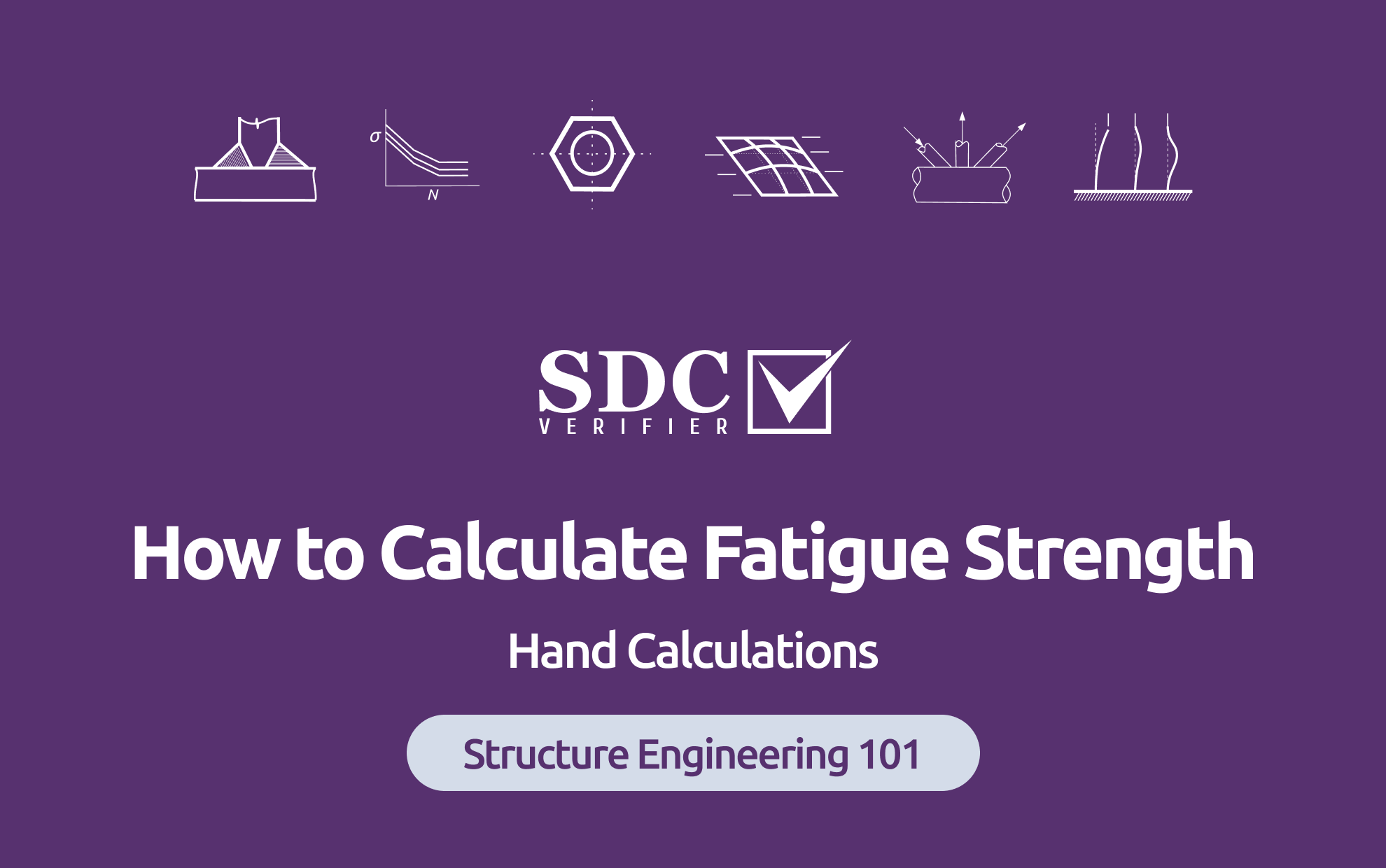How to Calculate Fatigue Strength (Hand Calculations)

This article focuses on calculating fatigue strength by hand. We’ll walk through the essential steps, from understanding the stress range and mean stress to applying correction factors and utilizing the S-N curve for accurate predictions.
Read our previous topics in our Fundamentals of Fatigue article series:
- What is Fatigue? (Definitions, Types, Causes)
- Fatigue Strength and Limit (Materials-Specific Data)
- Fatigue Life: Key Influencing Factors and Advanced Prediction Methods
- Fatigue Stress and Its Role in Structural Failure
While precise fatigue strength calculations often involve complex analysis and specialized software (like Finite Element Analysis or FEA), here’s a simplified approach using hand calculations that can provide an initial estimate:
1. Gather Material Properties
- Ultimate Tensile Strength (UTS): The maximum stress a material can withstand before fracture.
- Endurance Limit (or Fatigue Limit): The stress level below which the material can theoretically endure an infinite number of cycles without failure.
- For steels, this is often around 0.5 * UTS.
- For non-ferrous materials (aluminum, copper, etc.), a fatigue strength at a high number of cycles (e.g., 10^7 or 5 x 10^8 cycles) is used instead, as they don’t have a true endurance limit.
- Fatigue Strength Coefficient (σ’f) and Fatigue Strength Exponent (b): Parameters describing the material’s S-N curve (stress vs. number of cycles to failure).
- These can often be found in material property tables or estimated using empirical relationships.
2. Identify Loading Conditions
- Mean Stress (σm): The average stress level throughout the loading cycle.
- Stress Amplitude (σa): Half the difference between the maximum and minimum stress in the cycle.
- Stress Ratio (R): The ratio of minimum stress to maximum stress in the cycle (R = σmin / σmax).
3. Apply a Fatigue Failure Criterion
Several criteria exist, but a common one is the Goodman equation:
(σa / Se) + (σm / UTS) = 1
where:
- σa = Stress Amplitude
- σm = Mean Stress
- Se = Endurance Limit (or Fatigue Strength at a specified number of cycles)
- UTS = Ultimate Tensile Strength
4. Solve for Fatigue Strength
Rearrange the Goodman equation to solve for the allowable stress amplitude (σa), which represents the fatigue strength for the given loading conditions:
σa = Se * [1 - (σm / UTS)]
Important Considerations
- This is a simplified approach. Actual fatigue behavior can be influenced by many factors, including surface finish, temperature, corrosion, and stress concentrations.
- Safety factors are crucial in fatigue design. The calculated fatigue strength should be reduced by an appropriate factor to account for uncertainties and variability.
- For complex loading scenarios or critical applications, more advanced analysis methods (like FEA) and experimental testing are recommended.
- Material property data and fatigue failure criteria can vary depending on the source and specific application. Always consult relevant standards and guidelines.
Example
A steel component with UTS = 600 MPa and Endurance Limit (Se) = 300 MPa is subjected to cyclic loading with a mean stress (σm) of 100 MPa. Calculate the fatigue strength.
σa = Se * [1 - (σm / UTS)]
σa = 300 MPa * [1 - (100 MPa / 600 MPa)]
σa = 300 MPa * 0.833
σa = 250 MPa
Therefore, the estimated fatigue strength for this component under the given loading conditions is 250 MPa.
Remember: Always consult relevant engineering standards and guidelines and consider seeking expert advice for critical applications.
Disclaimer: This simplified approach is intended for educational purposes and initial estimations. It does not replace rigorous fatigue analysis and testing for critical applications.
Fatigue Calculators and Tools
While hand calculations are fundamental for understanding fatigue strength, there are moments when more than manual methods might be required. When dealing with complex geometries, large-scale projects, or industry-specific requirements, fatigue calculators and specialized tools provide a more robust solution.
When to Use Fatigue Calculators
Fatigue calculators are invaluable for intricate designs or components exposed to varied loading conditions. These tools allow you to verify hand calculations with greater precision, especially when multiple factors like stress concentration, loading histories, and complex geometries come into play. Large-scale projects also benefit from automation, saving time and reducing human error in repetitive calculations.
SDC Verifier Fatigue App: Industry-Grade Analysis Made Easy
The Fatigue App by SDC Verifier is designed to streamline fatigue checks across multiple industry standards. Leveraging the Palmgren-Miner rule and S-N curves, the app allows engineers to conduct fatigue analyses according to DIN 15018, DNV-RP-C203 Fatigue, Eurocode 3 Fatigue, and more.
One standout feature is the Weld Finder Tool, which automatically detects welded plates and handles different weld properties. It comprehensively summarizes forces and moments in local weld coordinate systems.
Combining Hand Calculations with Software
Relying on hand calculations and software tools like the SDC Verifier Fatigue App ensures you have a solid theoretical foundation and the power of detailed, automated analysis. This combination enhances accuracy and provides a complete perspective, especially for reporting and compliance with industry standards.
Conclusion
Mastering hand calculations for fatigue strength involves more than following equations; it consists of understanding how materials behave under cyclic stresses.
While modern software tools can automate much of the fatigue analysis process, the foundational knowledge gained from manual calculations could be more relevant. It equips engineers to critically assess results, troubleshoot issues, and make informed design decisions.
By combining these skills with advanced tools like the SDC Verifier Fatigue App, engineers can create safer, more reliable designs that stand the test of time. If you are interested in exploring the full capabilities of the Fatigue App, SDC Verifier offers a trial period, allowing you to test its features before committing.







